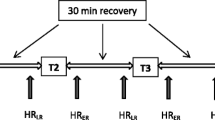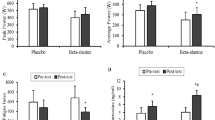Abstract
Purpose
This study aimed to analyze the effects of carbohydrate supplementation on strength parameters during a Brazilian Jiu-Jitsu (BJJ) simulated tournament.
Methods
Fourteen male BJJ amateurs athletes took part in a simulated tournament (3 × 8 min matches, 10-min rest), in a randomized double-blind, placebo-controlled, crossover trial. In two different sessions (7-day washout), BJJ athletes ingested 30 g of maltodextrin (CARB) or placebo (PLA). Were evaluated: maximal isometric handgrip strength (MIH), dynamic strength endurance [Kimono grip strength test dynamic (KGSTD)], muscular power [horizontal countermovement jump, (HCMJ)], ratings of perceived exertion (RPE), and lactate concentration.
Results
There was an interaction effect on MIH strength (p = 0.029 in right hand). MIH did not change during the tournament simulation in the CARB group, but decreased in the PLA group in the right-hand post-match. An interaction effect in KGSTD was observed (p = 0.006). Both groups had a decrease in KGSTD performance over the match; however, in the second interval, the CARB group showed higher strength than PLA. There was an interaction effect on HCMJ (p = 0.003). HCMJ increased during the tournament in the both groups. Lactate level and RPE indicated that exercise was intense and similar between the groups.
Conclusion
Carbohydrate supplementation provides a mild improve in the BJJ athlete’s strength during a simulated tournament.
Clinical trials
NCT03203785.



Similar content being viewed by others

References
Lima PODP, Lima AA, Coelho ACS, Lima YL, Almeida GPL, Bezerra MA, Oliveira RR (2017) Biomechanical differences in Brazilian Jiu-Jitsu athletes : the role of combat style. Int J Sports Phys Ther 12:67–75
Villar R, Gillis J, Santana G, Pinheiro DS, Almeida ALRA (2016) Association between anaerobic metabolic demands during simulated Brazilian Jiu-Jitsu combat and specific Jiu-Jitsu anaerobic performance test. J Strength Cond Res 32(2):432–440. https://doi.org/10.1519/JSC.0000000000001536
Andreato LV, Franchini E, De Moraes SMF, Pastório JJ, Da Silva DF, Esteves JVDC, Branco BHM, Da Romero PVS, Machado FA (2013) Physiological and technical-tactical analysis in brazilian jiu-jitsu competition. Asian J Sports Med 4:137–143. https://doi.org/10.5812/asjsm.34496
Andreato LV, Julio ÚF, Panissa VLG, Esteves JVDC, Hardt F, Moraes SMF, de Souza CO, Franchini E (2015) Brazilian jiu-jitsu simulated competition part I: metabolic, hormonal, cellular damage, and heart rate responses. J Strength Cond Res 29:2538–2549. https://doi.org/10.1519/JSC.0000000000000918
Andreato LV, Marta S, De MF, Victor J, Conti D, Miranda ML, Pastório JJ, Pastório EJ, Henrique B, Branco M, Franchini E (2014) Psychological, physiological, performance and perceptive responses to Brazilian Jiu-Jitsu combats. Kinesiology 46:44–52. https://doi.org/10.1249/MSS.0b013e3181ba8055
da Silva BVC, Ide BN, de Moura Simim MA, Marocolo M, da Mota GR (2014) Neuromuscular responses to simulated brazilian jiu-jitsu fights. J Hum Kinet 44:249–257. https://doi.org/10.2478/hukin-2014-0130
Bonato M, Rampichini S, Ferrara M, Benedini S, Sbriccoli P, Merati G, Franchini E, La Torre A (2015) Aerobic training program for the enhancements of HR and VO2 off-kinetics in elite judo athletes. J Sports Med Phys Fitness 55:1277–1284
Betts JA, Toone RJ, Stokes KA, Thompson D (2009) Systemic indices of skeletal muscle damage and recovery of muscle function after exercise: effect of combined carbohydrate-protein ingestion. Appl Physiol Nutr Metab 34:773–784. https://doi.org/10.1139/H09-070
Franchini E, Bezerra PL, da De Oliveira RSF, De Souza LC, De Oliveira DL (2005) Concentração de lactato sanguíneo, frequência cardíaca e força de preensão manual durante um combate de jiu-jitsu. Corpoconciência 9:35–44
Oliveira M, Moreira D, Godoy JRP, do Cambraia AN (2006) Avaliação da força de preensão palmar em atletas de jiu-jitsu de nível competitivo. Rev Bras Ciência e Mov 14:63–69
Julio UF, Panissa VLG, Esteves JVDC, Cury RL, Agostinho MF, Franchini E (2016) Energy system contributions to simulated judo matches. Int J Sports Physiol Perform 12:676–683. https://doi.org/10.1123/ijspp.2015-0750
Julio UF, Panissa VL, Cury RL, Agostinho MF, Esteves JV, Franchini E (2019) Energy system contributions in upper and lower body wingate tests in highly trained athletes. Res Q Exerc Sport 90(2):244–250. https://doi.org/10.1080/02701367.2019.1576839
Detanico D, Dellagrana RA, da Athayde MSS, Kons RL, Góes A (2016) Effect of a Brazilian Jiu-jitsu-simulated tournament on strength parameters and perceptual responses. Sports Biomech 3141:1–12. https://doi.org/10.1080/14763141.2016.1206143
Brito CJ, Gatti K, Mendes EL, Nóbrega OT, Córdova C, Marins JCB, Franchini E (2016) Carbohydrate intake and immunosuppression during judo training. Med Dello Sport 64:393–408
Burke LM, van Loon LJC, Hawley JA (2016) Post-exercise muscle glycogen resynthesis in humans. J Appl Physiol 122(5):1055–1067. https://doi.org/10.1152/japplphysiol.00860.2016
Gill SK, Teixeira AM, Rosado F, Cox M, Costa RJS (2016) High-dose probiotic supplementation containing Lactobacillus casei for 7 days does not enhance salivary antimicrobial protein responses to exertional heat stress compared with placebo. Int J Sport Nutr Exerc Metab 26:150–160. https://doi.org/10.1123/ijsnem.2015-0171
Cermak NM, Van Loon LJC (2013) The use of carbohydrates during exercise as an ergogenic aid. Sport Med 43:1139–1155. https://doi.org/10.1007/s40279-013-0079-0
Burke LM, Hawley JA, Wong SHS, Jeukendrup AE (2011) Carbohydrates for training and competition. J Sports Sci 29(Suppl 1):S17–27. https://doi.org/10.1080/02640414.2011.585473
Jackson AS, Pollock ML (1978) Generalized equations for predicting body density of men. Br J Nutr 40:497–504
Siri WE (1961) Body composition from fluid spaces and density: analysis of methods. Nutrition 9(5):480–491
Follmer B, Franchini E, Diefenthaeler F (2015) Relationship of kimono grip strength tests with isokinetic parameters in jiu-jitsu athletes. Rev Bras Cineantropometria e Desempenho Hum 17:575–582. https://doi.org/10.5007/1980-0037.2015v17n5p575
Markovic G, Dizdar D, Jukic I, Cardinale M (2004) Reliability and factorial validity of squat and countermovement jump test. J Strength Cond Res 18:551–555. https://doi.org/10.1519/1533-4287(2004)18<551
Borg GAV (1982) Psychophysical bases of perceived exertion. Med Sci Sports Exerc 14:377–381
Cohen J (1988) Statistical power analysis for the behavior. Lawrence Erlbaum Associates 2:20–27
Hopkings GW (2002) A scale of magnitudes for effect statistics suppose. Sport Sci 63–66
Franchini E, Takito MY, Alves ED, Shiroma SA, Julio UF, Humberstone C (2019) Effects of different fatigue levels on physiological responses and pacing in judo matches. J Strength Cond Res 33:783–792. https://doi.org/10.1519/JSC.0000000000003006
Andreato LV, Julio UF, Panissa VLG, Esteves JVDC, Hardt F, de Moraes SMF, de Souza CO, Franchini E (2015) Brazilian jiu-jitsu simulated competition part ii: physical performance, time-motion, technical-tactical analyses, and perceptual responses. J Strength Cond Res 29:2015–2025
Andreato LV, Franzói de Moraes SM, de Moraes L, Gomes T, Del Conti EJV, Vidal Andreato T, Franchini E (2011) Estimated aerobic power, muscular strength and flexibility in elite Brazilian Jiu-Jitsu athletes. Sci Sport 26:329–337. https://doi.org/10.1016/j.scispo.2010.12.015
Andreato LV, Lara FJD, Andrade A, Branco BHM (2017) Physical and physiological profiles of Brazilian Jiu-Jitsu athletes: a systematic review. Sport Med Open 3:9. https://doi.org/10.1186/s40798-016-0069-5
Pinho Júnior EA, Brito CJ, Santos WOC, Valido CN, Mendes EL, Franchini E (2014) Influence of cryotherapy on muscle damage markers in jiu-jitsu fighters after competition: a cross-over study. Rev Andaluza Med del Deport 7:7–12. https://doi.org/10.1016/S1888-7546(14)70054-1
Da Silva BVC, Marocolo Juniór M, Simim de MAM, Rezen de FN, Franchini E, Da Mota GR (2012) Reliability in kimono grip strength tests and comparison between elite and non-elite Brazilian Jiu-Jitsu players. Arch Budo 8:103–107. https://doi.org/10.12659/AOB.883023
da Silva BVC, Junior MM, de Simim MAM, Franchini E, da Mota GR (2014) Performance in kimono grip strength tests among Brazilian Jiu-Jitsu practitioners from different levels. J Combat Sport Martial Arts 5:11–15. https://doi.org/10.5604/20815735.1127447
Nassif C, Ferreira APA, Gomes AR, Silva LDM, Garcia ES, Marino FE (2008) Double blind carbohydrate ingestion does not improve exercise duration in warm humid conditions. J Sci Med Sport 11:72–79. https://doi.org/10.1016/j.jsams.2007.08.015
Acknowledgements
The authors would like to thank all research participants for their time and effort. Moreover, we would also like to thank Azambuja-Behring Jiu-Jitsu School and Sul Jiu-Jitsu Zona Norte School for their availability.
Funding
This paper does not have any research support.
Author information
Authors and Affiliations
Corresponding author
Ethics declarations
Conflict of interest
The authors declare no conflict of interest.
Ethics approval
All protocol was approved by local ethical research center at Universidade Federal de Ciências da Saúde de Porto Alegre (number 1.873.861).
Consent to participate
Informed consent forms of the research method, and the health and physical fitness questionnaire were completed.
Availability of data and material
If necessary, the authors will provide all data and material of this research.
Additional information
Publisher's Note
Springer Nature remains neutral with regard to jurisdictional claims in published maps and institutional affiliations.
Rights and permissions
About this article
Cite this article
Möller, G.B., Censi, M.T., Goulart, M.J.V.d.C. et al. Effect of carbohydrate supplementation on strength parameters during a Brazilian Jiu-Jitsu simulated tournament. Sport Sci Health 16, 561–569 (2020). https://doi.org/10.1007/s11332-020-00665-z
Received:
Accepted:
Published:
Issue Date:
DOI: https://doi.org/10.1007/s11332-020-00665-z



